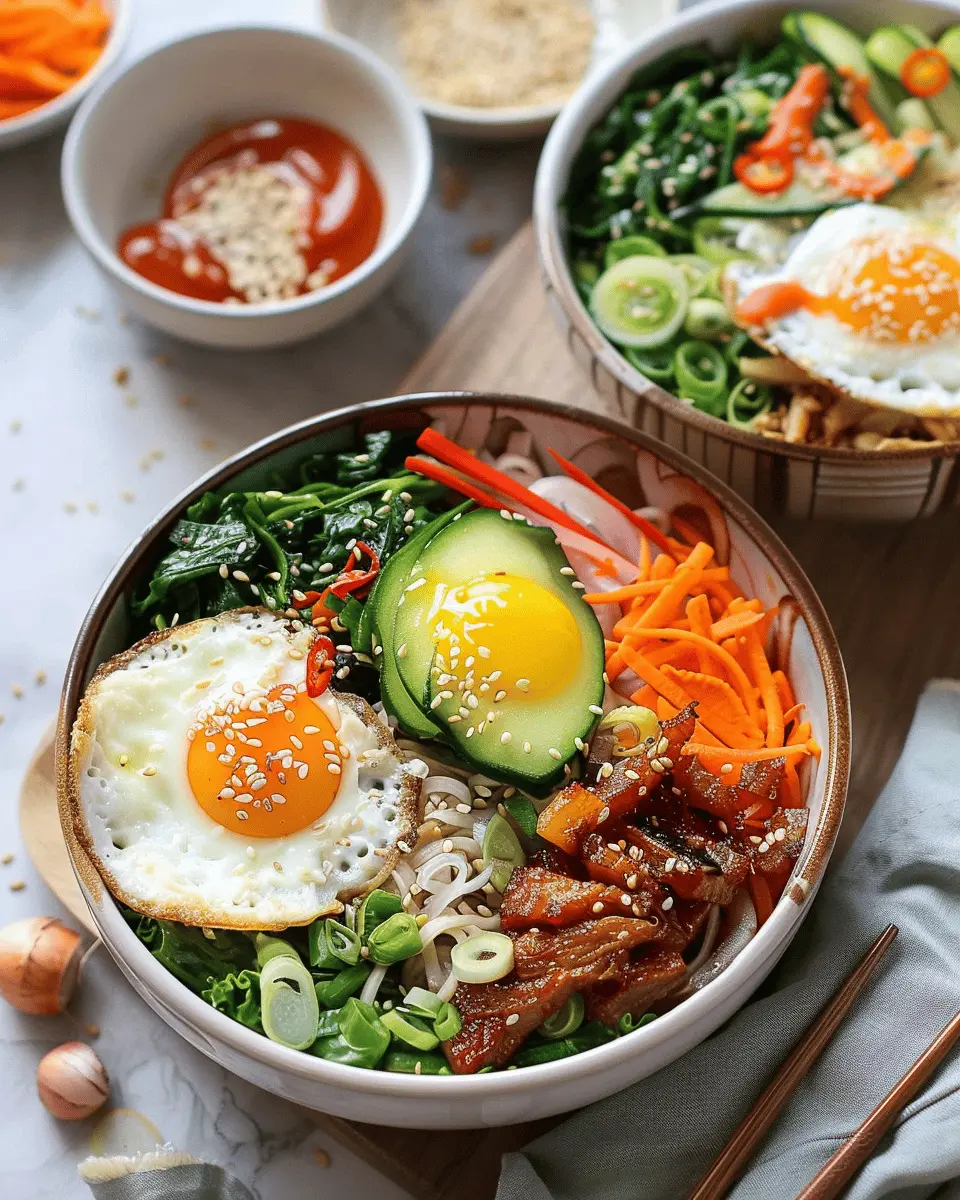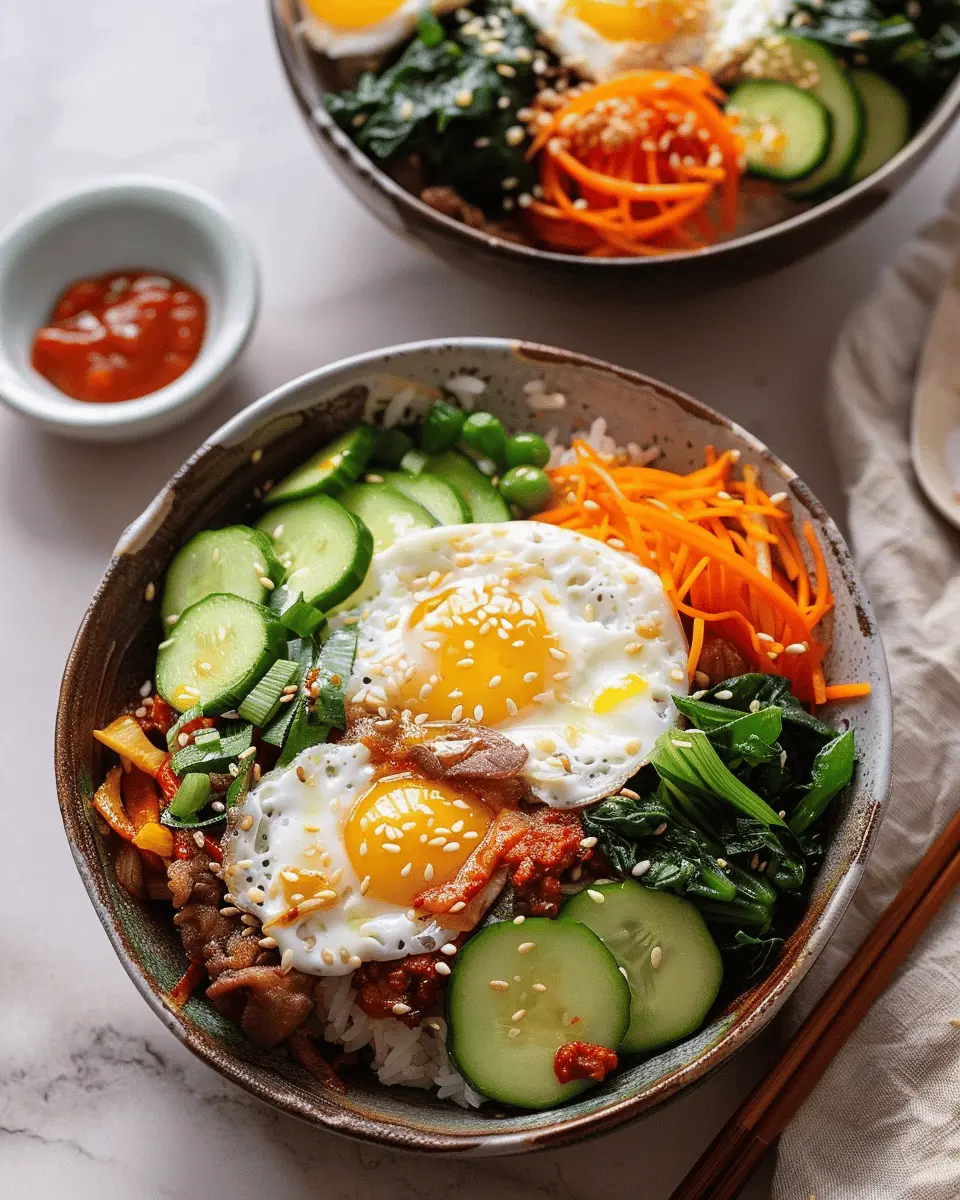Introduction to Korean Veggie Bibimbap Bowls
Korean Veggie Bibimbap Bowls are not just a meal; they’re an experience. Imagine a vibrant bowl brimming with colorful, sautéed vegetables, perfectly cooked rice, and a glorious dollop of spicy gochujang sauce. It’s the ultimate canvas for creativity and nutrition, making it a must-try for young professionals looking to spice up their weeknight dinners.
Why Korean Veggie Bibimbap is a Must-Try for Young Professionals
For young professionals juggling the demands of work and life, finding quick yet nutritious meals can be challenging. That’s where Korean Veggie Bibimbap comes in. This dish is not only easy to make, but it’s also a fantastic way to incorporate a variety of vegetables into your diet. In fact, a study published by the Centers for Disease Control and Prevention highlights that only about 1 in 10 adults consume enough vegetables daily. Bibimbap is an enjoyable way to hit that daily target.
What’s great about bibimbap is its versatility. You can customize it based on your taste preferences and what you have on hand. Whether you’re in the mood for some sautéed spinach, thinly sliced cucumbers, or even adding a bit of protein like turkey bacon or chicken ham, the options are endless. Each ingredient adds a unique flavor and texture, making every bite a delightful surprise.
But let’s also talk about time efficiency. With meal prepping, you can make a big batch of brown rice and roast a variety of veggies on a lazy Sunday. Then, throughout the week, simply assemble your beautiful bibimbap bowls in minutes. You save time without sacrificing flavor or nutrition.
If you’re curious about how this dish fits into a balanced diet, consider checking out resources from the Academy of Nutrition and Dietetics. Not only will you grasp the nutritional implications, but you’ll also see how easy meal diversity can benefit your health.
As you venture into the world of Korean cuisine, let Korean Veggie Bibimbap Bowls be that exciting introduction. It’s colorful, satisfying, and definitely Instagram-worthy!
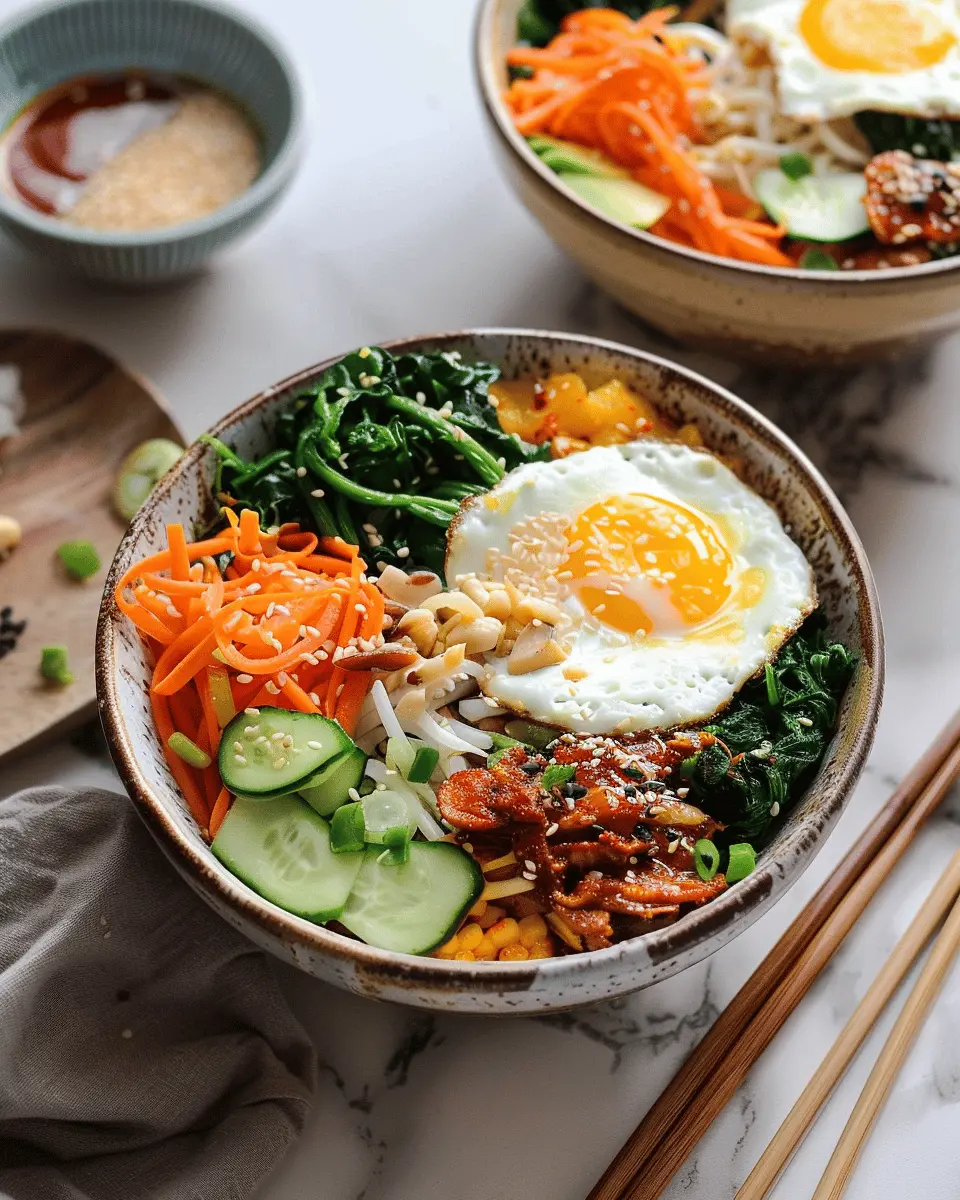
Ingredients for Korean Veggie Bibimbap Bowls
Pantry Essentials for Bibimbap
Creating delicious Korean Veggie Bibimbap Bowls at home begins with some essential pantry staples. Stock up on:
- Short-grain rice: This sticky rice is key to a successful bibimbap.
- Gochujang: This sweet and spicy Korean chili paste will add depth to your dish. A must-have!
- Soy sauce: For an umami kick that enhances the flavors of your veggies.
- Sesame oil: This fragrant oil adds a nutty richness that ties everything together.
- Pickled vegetables: Store-bought or homemade, these are critical for that zesty contrast.
For more pantry staples, check out Cooking with Korean Ingredients for a deeper dive.
Fresh Produce to Elevate Your Bowl
The heart of any bibimbap is its fresh ingredients. Here’s how to elevate your bowl:
- Spinach: Lightly sautéed, it adds color and nutrition.
- Carrots: Julienned or shaved for a crunchy texture.
- Zucchini: These can be shredded or sliced to add freshness.
- Mushrooms: Shiitakes or button mushrooms sautéed for earthy flavors.
- Radishes: Thinly sliced or pickled for a crisp bite.
Don’t forget, variety is key! Using seasonal veggies can make your Korean Veggie Bibimbap Bowls even more vibrant and flavorful.
Step-by-Step Preparation of Korean Veggie Bibimbap Bowls
Korean Veggie Bibimbap Bowls are not only packed with flavor, but they also offer a vibrant visual presentation, perfect for impressing friends or enjoying a cozy night in. Let’s dive into the step-by-step preparation to create these colorful, nutritious bowls right in your kitchen!
Preparing Your Ingredients
Before you begin, gather all your ingredients for a seamless cooking experience. Here’s what you’ll need:
- Base: Cooked white rice or brown rice—about 1 cup per bowl.
- Veggies: A mix of your favorites, such as spinach, carrots, zucchini, mushrooms, and bean sprouts.
- Protein: Optional additions like Turkey Bacon or Chicken Ham for those who want a protein kick.
- Eggs: Fresh eggs for frying.
- Sauce: Gochujang (Korean red chili paste) mixed with sesame oil, soy sauce, and a little sugar.
- Garnishes: Sesame seeds and green onions.
Having everything prepped—washed, sliced, and measured—will make the cooking process smooth. This means less time worrying about ingredients and more time enjoying the experience!
Cooking the Veggies
Having your veggies prepared is crucial to capturing their fresh flavors.
- Sauté Each Veggie Separately: Heat a little sesame oil in a pan over medium heat. Start with firmer veggies like carrots and zucchini, cooking them for about 2-3 minutes until they soften slightly.
- Add Delicate Greens Last: Following your heartier vegetables, add the spinach and bean sprouts, cooking them just until wilted—about another minute.
- Season: Sprinkle with salt, sesame seeds, and a dash of soy sauce for an umami boost. Doing this individually accentuates the flavors of each veggie.
Feeling like you need some inspiration? Check out fantastic vegetable cooking techniques on Serious Eats for tips to elevate your dishes.
Frying the Eggs Sunshine Style
The star of your Korean Veggie Bibimbap Bowls is a perfectly fried egg.
- Hot Pan: In a small non-stick skillet, heat a touch of oil over medium heat.
- Crack and Cook: Crack an egg into the pan, letting it sizzle. For that ideal “sunshine style,” cover it with a lid to steam the top while keeping the yolk runny.
- Perfectly Done: After about 2-3 minutes, the egg is ready when the whites are set but the yolk remains a gorgeous golden color.
Assembling Your Delicious Bowls
Now it’s time for the fun part—putting everything together!
- Base Layer: Start with a generous scoop of rice in each bowl, creating a warm fluffy canvas.
- Add the Veggies: Arrange your sautéed vegetables artfully around the rice. A little color-coordination makes for a visually stunning presentation.
Remember, the art of bibimbap is not only in the taste but also in the look. Take your time arranging the ingredients!
Adding the Flavorful Toppings
To elevate your Korean Veggie Bibimbap Bowls, don’t overlook the toppings.
- Fried Egg: Place your perfectly cooked egg in the center of the bowl.
- Sauces: Drizzle with your gochujang sauce to your taste. Start light if you’re sensitive to spice; you can always add more!
- Garnishes: Finish with a sprinkle of sesame seeds and sliced green onions for that beautiful crunch.
Feeling inspired? Try incorporating seasonal vegetables based on what’s fresh in your local farmers’ market for a personalized touch.
Bibimbap is a versatile dish, meaning you can express your creativity while enjoying healthy, delicious meals. So, gather your ingredients and get cooking; you won’t regret it!
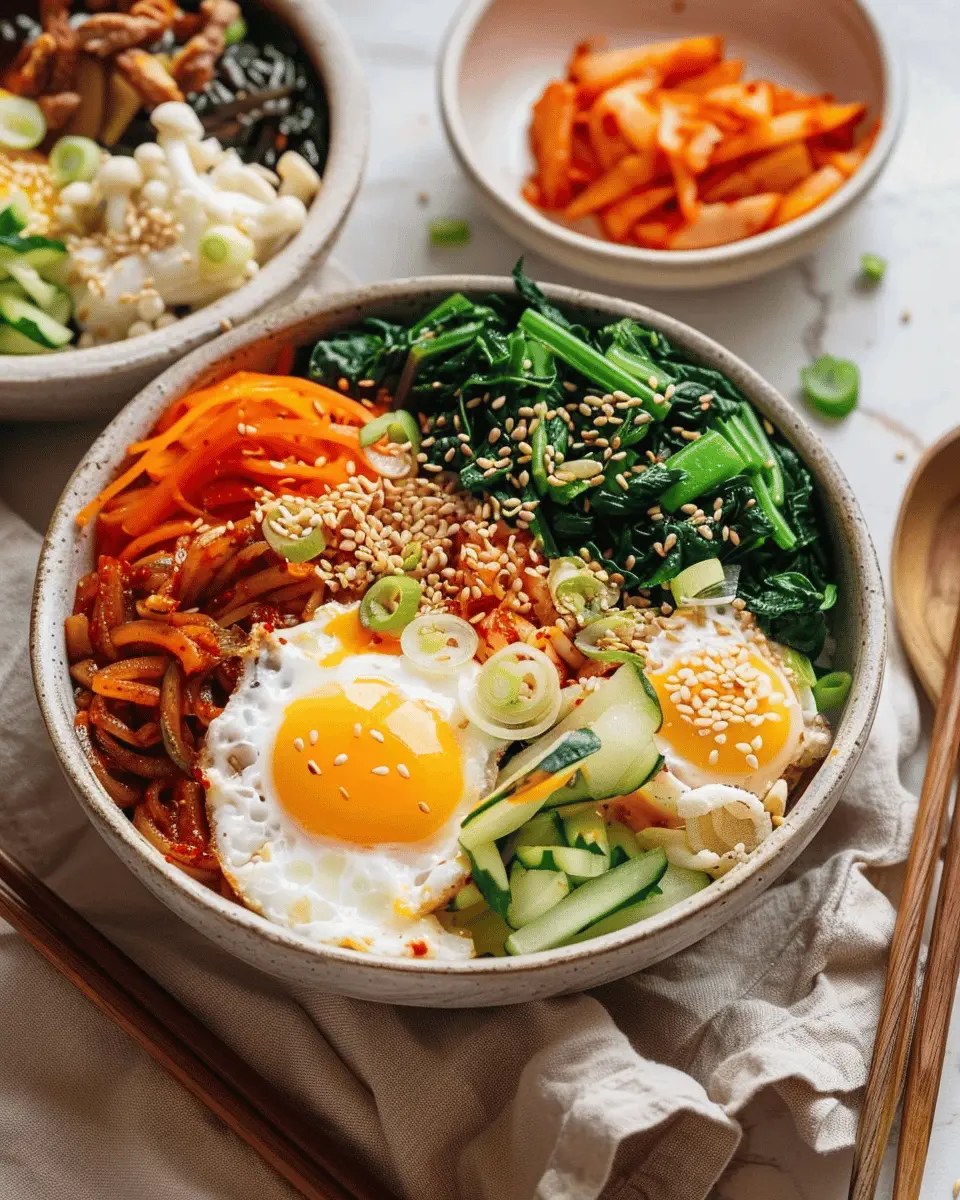
Variations on Korean Veggie Bibimbap
Korean Veggie Bibimbap Bowls are wonderfully versatile, making it easy to personalize them to suit your tastes and dietary preferences. Let’s explore some delicious variations that can elevate your meal!
Adding Protein: Tofu or Turkey Bacon Options
If you’re looking to enhance the nutritional profile of your bibimbap, consider adding a protein source. Tofu is an excellent choice, soaking up flavors beautifully when marinated. Simply cube and sauté until golden for a satisfying texture. For a meaty twist, try turkey bacon. It’s lower in fat than traditional bacon but still adds a delightful crunch. Just cook it until crispy and crumble it over your bowls—yum!
Going Vegan: Substitute Rice and Eggs
Switching to a vegan diet? No problem! For your base, consider swapping out traditional white rice for a healthier alternative like quinoa or cauliflower rice. Both options are a fantastic canvas for your veggies. When it comes to eggs, simply skip them or opt for scrambled tofu infused with turmeric for color and flavor. This way, you won’t miss the richness while still enjoying a fulfilling meal.
Seasonal Variations: Customize with What’s Fresh
One of the best parts of creating your Korean Veggie Bibimbap Bowls is the opportunity to use seasonal vegetables. Think of incorporating fresh asparagus in spring or hearty butternut squash in autumn. Not only does this keep your meals exciting, but it also supports local farmers and ensures you’re eating the best produce available.
By mixing and matching ingredients, you can create a dish that’s uniquely yours—deliciously satisfying, no matter your dietary choices.
Cooking Tips and Notes for Korean Veggie Bibimbap
Key Ingredients for Authentic Flavor
To create delicious Korean Veggie Bibimbap Bowls, you’ll want to focus on fresh and vibrant ingredients. Here are some essential components:
- Rice: Choose short-grain sticky rice for that perfect texture.
- Vegetables: Use a variety of colors! Spinach, carrots, zucchini, and mushrooms add both flavor and nutrition.
- Gochujang: This Korean chili paste delivers authentic spice; don’t skip it!
- Egg: A fried egg on top is classic, but you can also try a soft-boiled egg for a twist.
- Sesame oil: A drizzle brings the whole dish together.
Shortcuts for Busy Weekdays
Even busy professionals deserve a hearty meal! Here are some shortcuts to whip up your Korean Veggie Bibimbap Bowls without the fuss:
- Pre-cut vegetables: Grab pre-packaged veggies from the supermarket to save chopping time.
- Microwave rice: Instant rice options work in a pinch—just remember to season them!
- Batch cooking: Make a big batch of the veggies and store in the fridge for quick assembly throughout the week.
With these tips, mealtime can be a breeze! And don’t forget — you can check out more about Korean cuisine here.
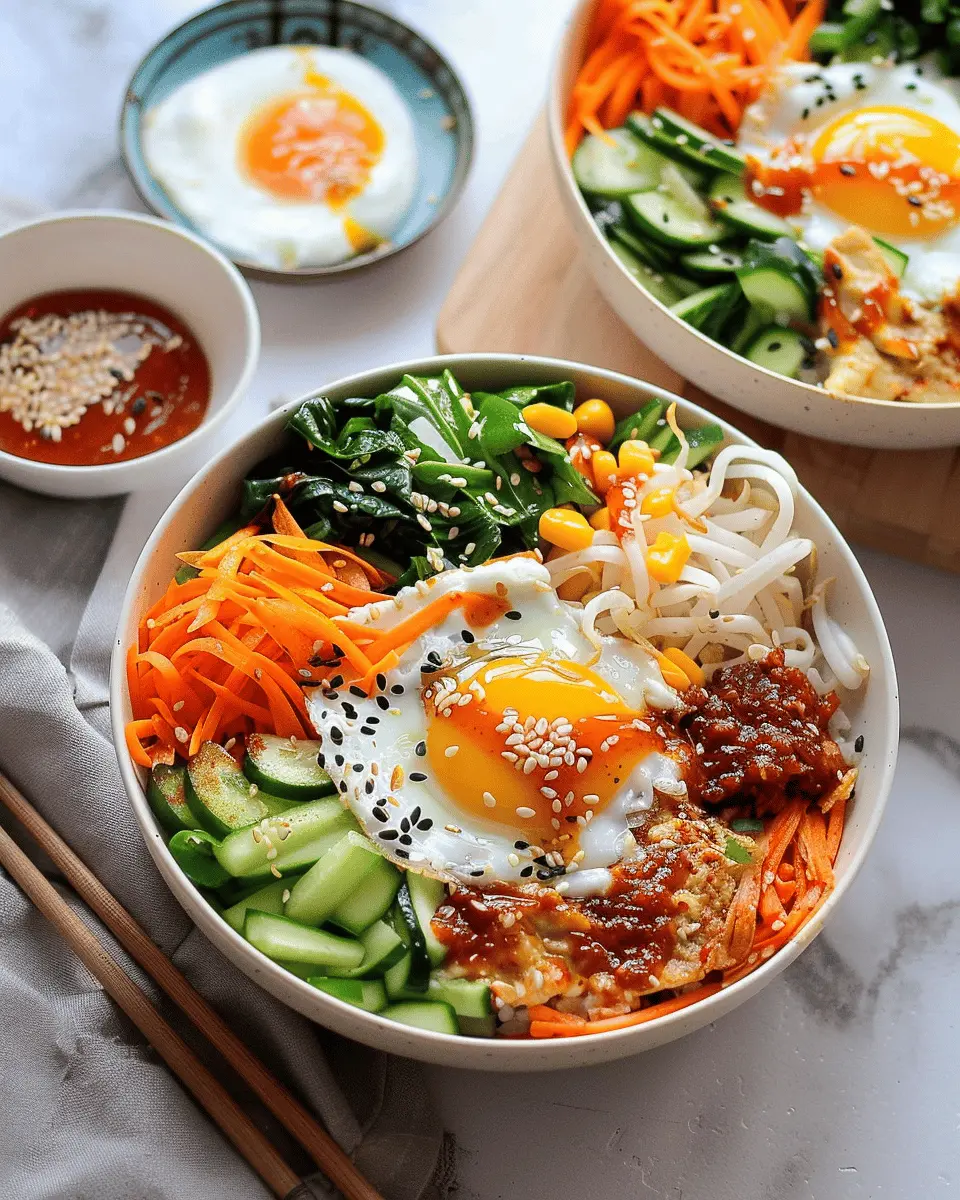
Serving Suggestions for Korean Veggie Bibimbap
Pairing with Korean Sides: Kimchi and More
When it comes to serving your Korean Veggie Bibimbap Bowls, the right sides can enhance the meal experience. Kimchi is an ideal accompaniment—its tangy, spicy kick balances the wholesome, earthy flavors of the bibimbap. If you’re new to kimchi, check out this kimchi guide for tips on selecting the perfect variety.
Here are a few more Korean sides that pair beautifully with your bibimbap:
- Korean Potato Salad: Creamy and mildly sweet, it offers a delightful contrast.
- Pickled Radishes: These add a refreshing crunch and a pop of color.
- Seasoned Spinach: A nutritious side that complements the meal’s texture.
Making It a Meal: Suggestions for Sides
To create a more substantial lunch or dinner with your Korean Veggie Bibimbap Bowls, consider these options:
- Turkey Bacon or Chicken Ham: Add protein by incorporating crispy turkey bacon or savory chicken ham, giving your meal a hearty twist.
- Steamed Edamame: These nutrient-rich pods are an easy, plant-based protein boost.
- Miso Soup: A warm bowl of miso soup can make for a comforting start or side.
With these suggestions, you can enjoy a well-rounded, satisfying Korean feast that’s sure to impress!
Time Breakdown for Korean Veggie Bibimbap
Preparation Time
Crafting your own Korean Veggie Bibimbap Bowls is a delightful experience that begins with about 20 minutes of prep. This gives you ample time to chop your veggies, cook your grains, and prepare your sauces. Pro tip: consider batching your veggie chopping to make future meals quicker!
Cooking Time
The actual cooking time comes in at around 30 minutes. This includes sautéing your vegetables and frying any protein additions like turkey bacon or chicken ham. The beauty of this dish is in its versatility—feel free to adjust the cooking methods to suit your kitchen style!
Total Time
In total, you’re looking at approximately 50 minutes from start to finish. Ready to dig into a bowl of vibrant flavors? With minimal time commitment, you can transport your taste buds to Korea without leaving your home! If you’re interested in learning some cooking tips or kitchen hacks, don’t forget to check out resources like Serious Eats for more culinary inspiration.
Nutritional Facts for Korean Veggie Bibimbap
Calories and Macronutrient Breakdown
A serving of Korean Veggie Bibimbap Bowls typically contains around 400-500 calories, making it a filling yet balanced meal. The macronutrient breakdown includes approximately:
- Carbohydrates: 60g (mainly from rice and vegetables)
- Protein: 15g (primarily from tofu or any added protein)
- Fats: 10g (healthy fats sourced from sesame oil and avocado)
This vibrant dish not only satisfies your hunger but also packs a nutritional punch, allowing you to enjoy a hearty meal without guilt.
Health Benefits of Key Ingredients
One of the great things about Korean Veggie Bibimbap Bowls is the variety of ingredients, each offering distinct health benefits:
- Brown Rice: A whole grain that provides fiber for digestive health and keeps you feeling satiated.
- Vegetables: Think spinach, carrots, and radishes, rich in vitamins and minerals. They contribute to improved immune function and overall well-being.
- Tofu: A fantastic source of plant-based protein and calcium, essential for muscle repair and strong bones.
- Sesame Oil: Contains antioxidants that promote skin health and may aid in heart health.
You can find more information on the health benefits of these ingredients through reliable sources such as Healthline or WebMD. The blend of nutritious components in Korean Veggie Bibimbap Bowls makes it not only delicious but also incredibly nourishing!
FAQ about Korean Veggie Bibimbap
Can you make bibimbap ahead of time?
Absolutely! Preparing your Korean Veggie Bibimbap Bowls in advance is not only convenient but also enhances the flavors. You can pre-cook the veggies and even the rice a day ahead. Just store them in airtight containers in the refrigerator. When it’s time to eat, simply reheat them, and you’ll have a delicious meal ready in minutes!
What’s the best way to store leftovers?
Leftovers are a delightful perk of making Korean Veggie Bibimbap. After enjoying your bowls, let any remaining ingredients cool, then store them in individual containers. This way, you can mix and match for quick lunches or dinners later. Make sure to store gochujang separately to control the spice level when you reheat your bibimbap.
How spicy is gochujang, really?
Gochujang is renowned for its unique flavor profile, combining heat, sweetness, and umami. On the spice scale, it’s generally considered mild to medium-hot. If you’re worried about the heat, start with a small amount and adjust to your liking. Remember, you can always add more, but it’s tough to take away! If you prefer a milder version, consider mixing it with some sesame oil or yogurt for a delicious dip.
For further insights into Korean cooking, check out Korean Banchan, which offers great resources and tips on various side dishes that complement bibimbap perfectly! Enjoy your culinary adventures with these tasty Korean Veggie Bibimbap Bowls, and don’t hesitate to share your creations with friends and family.
Conclusion on Korean Veggie Bibimbap Bowls
Embracing Homemade Goodness: A Culinary Adventure
In wrapping up our journey into the world of Korean Veggie Bibimbap Bowls, I hope you’ve caught a glimpse of the vibrant flavors and textures this dish offers. Creating your own bibimbap at home is not just a meal; it’s an adventure that invites creativity and joy into your kitchen. With fresh vegetables, nutrient-packed grains, and a dollop of savory sauce, you can tailor this dish to fit your taste buds perfectly.
Why not gather some friends for a Bibimbap night? Share your creations and get inspired by their combinations. Cooking can be as much about connection as it is about food. If you’re looking for more insights on Korean cuisine, check out resources like Korean Bapsang for authentic recipes and tips. Happy cooking!
PrintKorean Veggie Bibimbap Bowls: Easy, Flavor-Packed Plant Power
A delicious and healthy dish packed with vibrant vegetables and flavorful sauces.
- Prep Time: 15 minutes
- Cook Time: 15 minutes
- Total Time: 30 minutes
- Yield: 2 servings 1x
- Category: Main Course
- Method: Stovetop
- Cuisine: Korean
- Diet: Vegetarian
Ingredients
- 1 cup cooked rice
- 1 cup spinach
- 1 carrot julienned
- 1 zucchini sliced
- 1 cup bean sprouts
- 2 eggs
- 2 tablespoons soy sauce
- 1 tablespoon sesame oil
- 1 teaspoon gochujang (Korean chili paste)
- 1 tablespoon sesame seeds
Instructions
- Prepare the rice according to package instructions.
- In a pan, sauté spinach until wilted, then remove.
- Sauté julienned carrots and zucchini until slightly tender.
- In the same pan, add bean sprouts and cook for a few minutes.
- Fry eggs sunny-side up.
- In a bowl, layer the rice, sautéed vegetables, and top with the fried egg.
- Drizzle with soy sauce and sesame oil, and add gochujang.
- Sprinkle with sesame seeds before serving.
Notes
- Feel free to add or substitute any of your favorite vegetables.
- Adjust the spice level by adding more or less gochujang.
Nutrition
- Serving Size: 1 bowl
- Calories: 450
- Sugar: 3g
- Sodium: 800mg
- Fat: 20g
- Saturated Fat: 4g
- Unsaturated Fat: 12g
- Trans Fat: 0g
- Carbohydrates: 60g
- Fiber: 5g
- Protein: 12g
- Cholesterol: 180mg
Keywords: bibimbap, Korean, veggie, plant-based, easy recipes
